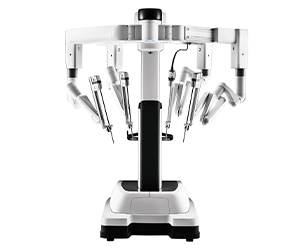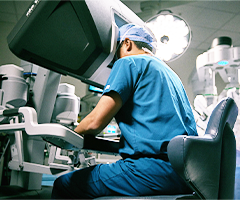Robotic Coronary Artery Bypass Surgery
Coronary Artery Disease
Coronary artery disease, also called coronary heart disease, is a common form of heart disease that occurs when the arteries that bring blood to the heart narrow or become clogged by plaque—a buildup of fat, cholesterol, calcium, and other substances in the blood. For severe cases, surgery widens or unblocks clogged arteries to increase the flow of blood and oxygen to the heart.
da Vinci Artery Bypass Surgical Approach
In traditional bypass surgery, doctors access the heart by making an 8- to 10-inch incision down the chest and opening the ribs—this is known as a sternotomy. Surgeons then take a segment of a healthy blood vessel from your chest, leg or arm and attach one end of that vessel to a healthy artery and the other end to the diseased coronary artery past the clogged area.
This creates a new channel, allowing blood to flow freely again. A pump oxygenator—heart-lung machine—is used for many coronary bypass operations. It takes over the function of the heart and lungs during surgery.

We perform daVinci surgery for coronary artery disease without the need for a heart-lung machine. It uses a minimally invasive approach with only small incisions between the ribs. This also avoids the need for a sternotomy.
Potential Benefits Include:
- Shorter hospital stay and faster recovery
- Less pain, scarring and risk of infection
- Significantly less blood loss and need for blood transfusions
- Quicker return to normal activities
- Significantly less risk of heart attack and stroke following surgery
- Superior results with less need for repeat surgery
- Significantly higher patient satisfaction
Ready to Take the Next Steps?
Related To Coronary Bypass Surgery
-
The da Vinci™ Surgical System
Lee Health's da Vinci technology enables your surgeon to operate with enhanced precision and control.
-
Robotic Surgery at Lee Health
Robotic-assisted surgery enables your surgeon to operate with enhanced precision and control.


